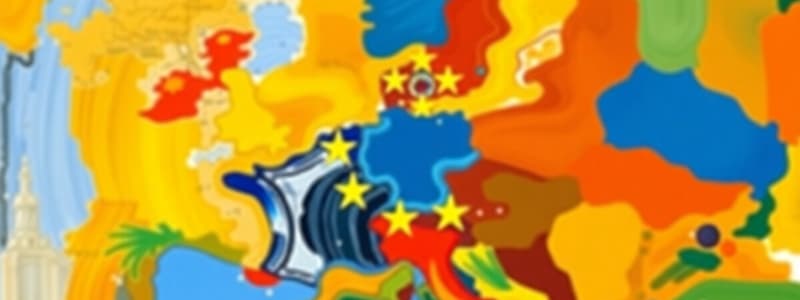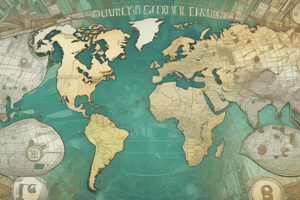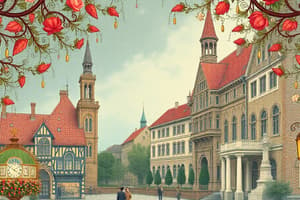Podcast
Questions and Answers
What is a characteristic of a Free Trade Area?
What is a characteristic of a Free Trade Area?
- A common external tariff is applied to imports.
- Free movement of labor and capital is allowed.
- Complete unification of monetary policy occurs.
- States remove customs duties and quotas on trade between them. (correct)
A Customs Union allows for different tariffs to be applied by member states on goods entering the Union.
A Customs Union allows for different tariffs to be applied by member states on goods entering the Union.
False (B)
What are the four freedoms of the EU's Common Market?
What are the four freedoms of the EU's Common Market?
Goods, capital, services, people
The Economic and Monetary Union represents a complete unification of __________ and fiscal policy with a common currency.
The Economic and Monetary Union represents a complete unification of __________ and fiscal policy with a common currency.
Match the following stages of economic integration with their descriptions:
Match the following stages of economic integration with their descriptions:
What is the primary challenge in creating a common market across multiple states?
What is the primary challenge in creating a common market across multiple states?
Negative integration involves creating new rules and institutions.
Negative integration involves creating new rules and institutions.
What are the two main types of integration methods in creating a common market?
What are the two main types of integration methods in creating a common market?
The usual model of economic interactions between states is based on __________ control.
The usual model of economic interactions between states is based on __________ control.
Match the following integration methods with their definitions:
Match the following integration methods with their definitions:
Which of the following is an example of a host country control?
Which of the following is an example of a host country control?
Why do theoretical models of market integration not exist in pure form?
Why do theoretical models of market integration not exist in pure form?
Which of the following best describes the internal market as defined in Article 26 TFEU?
Which of the following best describes the internal market as defined in Article 26 TFEU?
The internal market is intended to be a completed project in EU law.
The internal market is intended to be a completed project in EU law.
What powers exist to regulate the internal market in the EU?
What powers exist to regulate the internal market in the EU?
The internal market ensures the free movement of ______, persons, services, and capital.
The internal market ensures the free movement of ______, persons, services, and capital.
Match the following terms related to the internal market with their descriptions:
Match the following terms related to the internal market with their descriptions:
What kind of model does the EU use for market integration?
What kind of model does the EU use for market integration?
The EU has absolute trust in member states to apply their national rules without exceptions.
The EU has absolute trust in member states to apply their national rules without exceptions.
What does home country control imply in the context of market integration?
What does home country control imply in the context of market integration?
The EU harmonizes its regulations but allows member states to have some discretion known as _____ harmonization.
The EU harmonizes its regulations but allows member states to have some discretion known as _____ harmonization.
Match the terms with their descriptions:
Match the terms with their descriptions:
What is a consequence of market integration regarding sovereignty?
What is a consequence of market integration regarding sovereignty?
Worker regulations in the EU prioritize rules of the host country over the home country.
Worker regulations in the EU prioritize rules of the host country over the home country.
What are some democratic concerns associated with market integration?
What are some democratic concerns associated with market integration?
In the harmonised model of the EU, all products/services must comply with ____ standards.
In the harmonised model of the EU, all products/services must comply with ____ standards.
Which of the following best summarizes the EU's approach to product standards?
Which of the following best summarizes the EU's approach to product standards?
Flashcards are hidden until you start studying
Study Notes
Economic and Monetary Union
- The European Union (EU) aims to remove barriers to trade between its member states
Stages of Market Integration
- Free Trade Area: Removes all tariffs and quotas on goods traded between member states but maintains individual external tariffs
- Customs Union: Extends the Free Trade Area by adding a common external tariff for goods entering the union from outside
- Common Market: Builds on the customs union by adding free movement of labor, capital, and services. Aims for optimal allocation of resources
- Economic Union: Creates a complete common market by unifying economic policies, coordinating fiscal and monetary policies
- Economic and Monetary Union: Goes beyond the economic union by adding a single currency and full unification of monetary policy. It's almost achieved in the Eurozone
- Positive Integration: Creating new rules and institutions to regulate trade.
- Negative Integration: Removing barriers to trade
Methods of Market Integration
- Host Country Control: Economic activity is governed by the rules of the country where it takes place
- Harmonised Model: Creates one set of rules for the entire economic market that all countries need to comply with
- Home Country Control: Rules of origin apply. If a product is made in country A and sold in country B, country A's rules apply
What is trade?
- Article 26 of the Treaty on the Functioning of the European Union (TFEU) defines the internal market as an area without internal frontiers
- Four Freedoms:
- Free movement of goods
- Free movement of people (workers)
- Freedom of establishment and the provision of services
- Free movement of capital
Studying That Suits You
Use AI to generate personalized quizzes and flashcards to suit your learning preferences.




